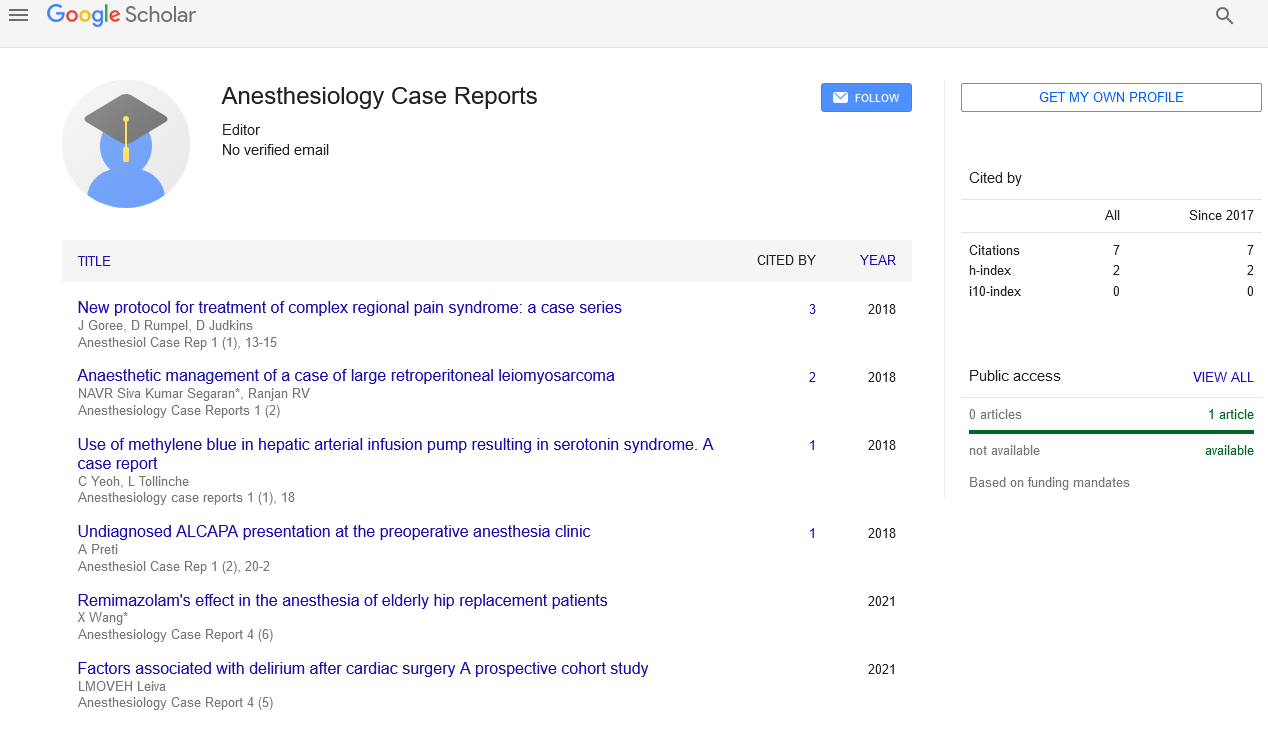Sedation in anesthesiology: A comprehensive overview
Received: 06-Aug-2024, Manuscript No. pulacr-24-7235; Editor assigned: 08-Aug-2024, Pre QC No. pulacr-24-7235; Accepted Date: Sep 02, 2024; Reviewed: 13-Aug-2024 QC No. pulacr-24-7235; Revised: 24-Aug-2024, Manuscript No. pulacr-24-7235; Published: 04-Sep-2024
Citation: Costea R. Sedation in anesthesiology: A comprehensive overview.Anesthesiol: Case Rep. 2024; 7(5):1-2.
This open-access article is distributed under the terms of the Creative Commons Attribution Non-Commercial License (CC BY-NC) (http://creativecommons.org/licenses/by-nc/4.0/), which permits reuse, distribution and reproduction of the article, provided that the original work is properly cited and the reuse is restricted to noncommercial purposes. For commercial reuse, contact reprints@pulsus.com
Abstract
Sedation is a vital component of anesthesiology, enabling patients to undergo various medical procedures with minimal discomfort and anxiety. This article provides an overview of sedation types, pharmacological agents, clinical indications, and associated risks. By examining these facets, healthcare professionals can enhance patient care, improve procedural outcomes, and ensure safety during sedation practices.
Key Words
Sedation; Anesthesia; Pharmacology; Patient safety
Introduction
Sedation is an integral part of modern medical practice, particularly in the field of anesthesiology. It involves administering medications to calm patients, alleviate pain, and facilitate medical procedures while ensuring patient safety. Unlike general anesthesia, which results in a complete loss of consciousness, sedation allows patients to remain conscious but relaxed. This balance is crucial for procedures ranging from diagnostic tests to minor surgeries. Understanding the different types of sedation, the agents used, and the potential risks is essential for healthcare providers in optimizing patient outcomes and experiences [1].
Types of sedation
Sedation can be classified into several levels, each defined by the depth of sedation and the patient's responsiveness:
Minimal sedation (anxiolysis): In this state, patients are awake and alert, experiencing reduced anxiety. They can maintain their own airway and respond to verbal commands. This level is often achieved with oral or intravenous benzodiazepines.
Moderate sedation (conscious sedation): Patients may be drowsy and less aware of their surroundings but can respond purposefully to verbal commands or light tactile stimulation. Monitoring is still necessary to ensure airway safety [2].
Deep sedation: Patients are less arousable and may respond only to repeated or painful stimuli. This level requires careful airway management, as patients may not protect their airways effectively.
General anesthesia: Although not classified as sedation, general anesthesia involves a complete loss of consciousness and sensation, requiring intensive monitoring and airway management.
Pharmacological agents
Various medications are used to achieve sedation, with choices depending on the desired level of sedation, the patient's health status, and the nature of the procedure. Commonly used agents include:
Benzodiazepines (e.g., midazolam): These medications are widely used for their anxiolytic and amnesic effects. They act quickly and can be reversed if necessary [3].
Opioids (e.g., fentanyl): Used primarily for pain relief, opioids are often combined with sedatives to enhance patient comfort during procedures.
Propofol: This agent is favored for moderate to deep sedation due to its rapid onset and short duration of action. However, it requires careful monitoring due to potential respiratory depression.
Ketamine: Known for its analgesic and dissociative properties, ketamine is particularly useful in emergency situations and in patients with a history of pain.
Dexmedetomidine: This relatively new agent provides sedation without significant respiratory depression, making it ideal for procedures requiring deeper sedation while preserving airway reflexes.
Indications for sedation
Sedation is indicated in a variety of clinical scenarios, including:
Diagnostic procedures: Many procedures, such as endoscopies and colonoscopies, require sedation to improve patient comfort and cooperation [4].
Surgical interventions: Outpatient surgeries often utilize sedation to reduce anesthesia-related risks and enhance recovery.
Pain management: Sedation is frequently used alongside analgesics for procedures like nerve blocks or chronic pain interventions medical procedures, sedation can facilitate a more positive experience.
Risks and considerations
While sedation is generally safe, it carries inherent risks. Potential complications include respiratory depression, airway obstruction, and adverse reactions to medications. Patient factors such as age, underlying health conditions, and the complexity of the procedure can influence these risks. Therefore, thorough preoperative assessments, vigilant monitoring during the procedure, and readiness to manage emergencies are critical [5].
Healthcare providers must also be familiar with the regulations and guidelines surrounding sedation practices in their specific regions. Adhering to established protocols is essential for ensuring patient safety and maintaining high care standards.
Conclusion
Sedation is a crucial aspect of anesthesiology, significantly enhancing patient comfort and procedural efficacy. By understanding the types of sedation, pharmacological agents, indications, and associated risks, healthcare providers can deliver effective and safe sedation practices. Continuous education and training are vital as the field evolves, ensuring that patient safety remains a top priority.
Anxiety management: For patients with significant anxiety about management and assessment, sedation can greatly improve patient outcomes and overall satisfaction in clinical settings.
References
- Sanfilippo F, Noto A, Foresta G, et al. Incidence and factors associated with burnout in anesthesiology: a systematic review. BioMed research international. 2017; 2017(1):8648925. [GoogleScholar] [Crossref]
- Tripathi RS, Blum JM, Papadimos TJ, et.al. A bibliometric search of citation classics in anesthesiology. BMC anesthesiology. 2011 Dec; 11:1-7. [GoogleScholar] [Crossref]
- Boulet JR, Murray DJ, Warner DS. Simulation-based assessment in anesthesiology: requirements for practical implementation. The Journal of the American Society of Anesthesiologists. 2010 Apr 1; 112(4):1041-52. [GoogleScholar] [Crossref]
- Volquind D, Bagatini A, Monteiro GM, et al. Occupational hazards and diseases related to the practice of anesthesiology. Brazilian Journal of Anesthesiology (English Edition). 2013 Mar 1; 63(2):227-32. [GoogleScholar] [Crossref]
- Naik VN. New directions in medical education related to anesthesiology and perioperative medicine. Canadian Journal of Anesthesia. 2012 Feb 1; 59(2):136. [Google Scholar] [Crossref]





